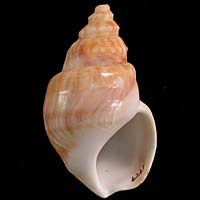|
< Previous family introduction |
|
|||||
 |
Family Struthiolariidae Ostrich foot snails |
|||||
|
The family Struthiolariidae is a small family of molluscs now restricted to the cool temperate waters of the southern hemisphere. They have a long fossil history, particularly in the Antarctic. There are only five living species; two occur in New Zealand, one on South Georgia in the Southern Ocean, one on Kerguelen Island, also in the Southern Ocean, and one is restricted to NSW. Struthiolariids live in the intertidal and shallow subtidal, where they bury in sand or mud. They are filter feeders, drawing in water and passing it over the gill to extract plankton, which is moved to the mouth by cilia in a mucous string. They may be recognised in their feeding position by a mound accompanied by two holes, for water inflow and outflow. The inlet hole is made by the feeding proboscis (there is no siphon) and the outflow hole is formed by a single tentacle which protrudes through the hole to make contact with the surface. The holes are lined with mucous to strengthen the sand. Sexes are separate and fertilisation is internal. In the larger New Zealand species, Struthiolaria papulosa, the female has brood pouches in the mantle cavity where young develop, to be released into the plankton. For the single NSW species, Tylospira scultulata, the narrow distributional range suggests there is not a free-swimming stage, as is the case with the smaller New Zealand species, Pelicaria vermis. The single species that occurs is NSW is restricted to eastern Australia, from Burleigh Heads, Queensland, to Twofold Bay, NSW. Family Reference The following reference describes the nine fossil and one living species in Australia: Darragh, T. A. 1991. A revision of the Australian genus Tylospira Harris, 1897 (Gastropoda: Struthiolariidae). Alcheringa 15: 151-175. Coverage The species described here is the only living NSW representative of the family. Identification Notes The glazed shell and unusual lip shape is sufficient to distinguish the only NSW representative of the family. |